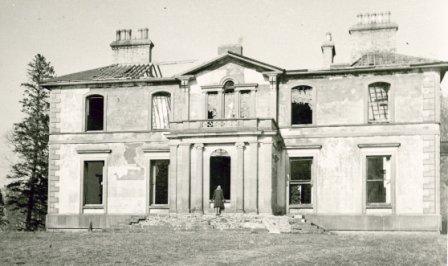Moyriesk
Houses within 5km of this house
Displaying 12 houses.
Houses within 5km of Moyriesk
Displaying 12 houses.
| House name | Description | |
|---|---|---|
| Dangan | The main residence of the Creagh family in the 18th and 19th centuries, held by Cornelius Creagh in fee at the time of Griffith's Valuation when the house was valued at over £25.. Sold in the 1920s, the Irish Tourist Association Survey file records the house as dilapidated and going to ruin in the 1940s. Weir writes that the house was demolished in 1948. | |
| Cranagher | Originally a Bindon home this property passed to the Blood family through a marriage in the 1770s. In 1814 it was occupied by Mr James Kerin and in the mid 19th century by Giles Darcy who held it from William Blood. The house was valued at less than £2. There is a substanial house and demesne marked on the first Ordnance Survey map at Cranagher. Weir writes that a new house was started sometime in the 19th century a short distance from the original but was abandoned before completion. General Sir Bindon Blood sold Cranagher in 1905. Some farm building and modern houses exist at the site now. | |
| Castletown House | The original house is now demolished and a 20th century house stands on the site close to an old Macnamara castle. The house was occupied by Francis Macnamara in 1814 and by Robert Malcolm in the mid 19th century who held it from Colonel George Wyndham. It was valued at £10. | |
| Tooreen | Originally a residence of Augustine Fitzgerald, occupied by John Kerin in 1814 and by W. O'Connell in 1837. James Hynes was in possession of the house in the mid 19th century. He held it from Maurice O'Connell and it was valued at £10. It is now a ruin. | |
| Hazelwood | Occupied by Hugh Singleton in the mid 19th century and held from the representatives of Charles Mahon. The buildings were valued at £31. The house remained a Singleton residence until it was burnt in 1921. | |
| Clooney House | Originally a 17th century house, the home of the Bindon family, it was burnt in the 19th century. Lewis refers to "Clonie, the demesne of Burton Bindon" in 1837. At the time of Griffith's Valuation the house was unoccupied and William S. Vesey Fitzgerald was the immediate lessor. Rebuilt in the latter half of the 19th century by Joseph Hall and his wife Ellen Bindon. The house was bought by the Tuckeys following the death of Joseph Hall in 1907, the land was divided in the 1920s and the house went to ruin. |

|
| Corbally | The Spaights were resident at Corbally from the latter part of the 18th century. Poole Gabbett was resident here in the first decade of the 19th century. Griffith's Valuation show that the Spaights held Corbally from the Mahon family "of Corbally". The house appears to have reverted back to the Mahons in the later part of the 19th century. Slater notes it as the residence of George T.M Stacpoole in 1894. | |
| Toonagh | A home of a branch of the Miller family, probably descended from Henry Miller, uncle to Sir John Riggs Miller. By the mid 19th century Toonagh was unoccupied and the surrounding land was in the possession of John Blood Smyth who held it from William C. Judd. The house is still a residence. | |
| Ballykilty | A McMahon residence in the 1730s, In 1786 Wilson notes it as the seat of Mr. McMahon. Weir writes that the lease of Ballykilty was purchased by John Blood in 1785. Occupied by Robert Young in 1814 and by John Blood in 1837 and at the time of Griffith's Valuation. He held the property from William Monsell. The front of the house was replaced following a fire in the 19th century. Functioned as a hotel in the latter part of the 20th century and now the site of a major hotel development. | |
| Brook Lodge/Dangan Ville | Occupied by William O'Connell in 1814 and by Pierce O'Brien who held it from Pierce Creagh in the mid 19th century, when the house was valued at over £13. By the 1870s this house, which is labelled Brooke Lodge on the 25-inch map of the 1890s, was the residence of Nicholas Henry Martin. A house is still extant at this site. | |
| Quinville House | An 18th century house, Lewis writes that it was rebuilt in the early 19th century in the Elizabethean style, home of the Singleton family. In 1906 Quinville was in the possession of James Butler Ievers. The property was bought by the McCausland family of Drenagh, county Derry in the 20th century. In the late 1990s the house was undergoing a major restoration by the owners, the Houlihan family. in 2012 it was offered for sale. |

|
| Ballyhannon | Weir writes that this is a mid 19th century house and was the home of Thomas Studdert. This house valued at £24 was occupied by his representatives in 1906. It is still extant. |

|

